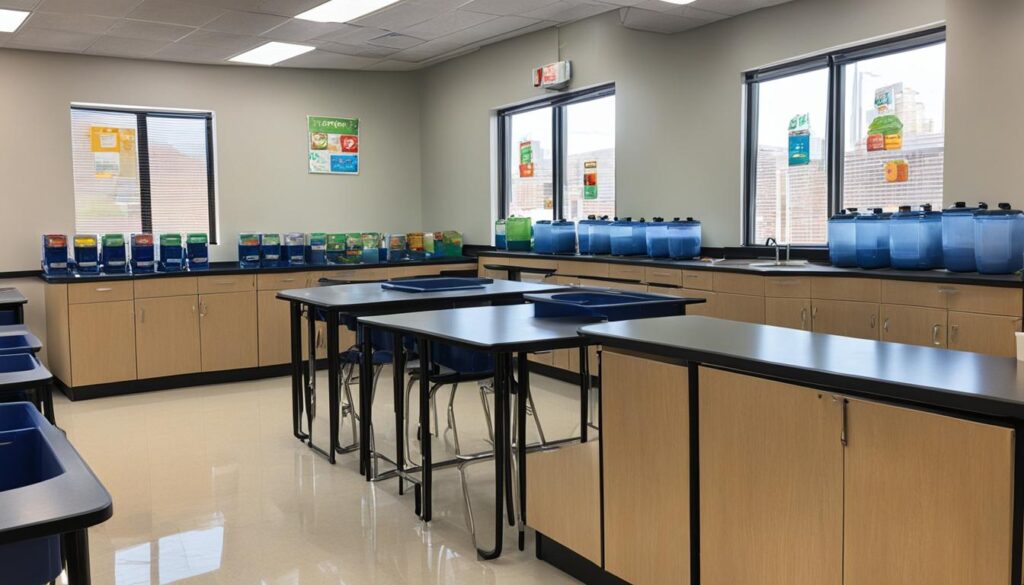As a journalist specializing in health and wellness, I am constantly exploring strategies and interventions that can effectively combat obesity among young individuals. In this article, I will delve into the important role that schools play in obesity prevention and discuss the various school-based interventions that can have a significant impact on students’ health and well-being.
Key Takeaways:
- Schools have a unique opportunity to improve youth health and combat obesity through various interventions.
- By incorporating nutrition and physical activity lessons into the curriculum, promoting health outside of the classroom, and implementing wellness programs, schools can play a crucial role in preventing obesity.
- Integrating nutrition and physical activity lessons can empower students to adopt and maintain healthy lifestyles.
- Creating a healthy school environment by offering nutritious meals, eliminating the marketing of unhealthy foods, and promoting safe walking and biking routes can contribute to obesity prevention.
- Gathering school data on student health, such as body mass index (BMI), can help assess the effectiveness of current programs and guide future initiatives.
Incorporating Nutrition and Physical Activity Lessons
Schools play a crucial role in promoting healthy habits and preventing obesity among students. By incorporating nutrition and physical activity lessons into the curriculum, schools can equip students with the knowledge and skills necessary to make informed choices about their health. These lessons can be integrated into core classroom subjects, physical education classes, and after-school programs, ensuring that students receive a comprehensive education on nutrition and physical fitness.
Through nutrition education, students learn about the importance of balanced diets, portion control, and the benefits of consuming nutritious foods. They gain knowledge of essential nutrients, food groups, and the impact of healthy eating on their overall well-being. By understanding the relationship between nutrition and health, students are empowered to make healthier food choices and develop lifelong habits.
Physical activity lessons focus on the importance of regular exercise for maintaining a healthy weight and overall physical fitness. Students learn about different types of physical activities, such as aerobic exercises, strength training, and flexibility exercises. They also discover the benefits of physical activity for their mental well-being and academic performance. By incorporating enjoyable and age-appropriate physical activities, schools can motivate students to engage in regular exercise and lead active lifestyles.
“Nutrition education and physical activity lessons in schools provide students with the tools they need to make healthy choices and maintain a balanced lifestyle. By integrating these lessons into the curriculum, schools can instill lifelong habits that contribute to preventing obesity and promoting overall well-being.”
Furthermore, these lessons can be reinforced through school-wide initiatives and partnerships with community organizations. For example, schools can organize cooking demonstrations, farm-to-school programs, and healthy eating challenges to further enhance students’ understanding of nutrition and encourage them to apply their knowledge outside of the classroom.
Benefits of Incorporating Nutrition and Physical Activity Lessons in Schools
Integrating nutrition and physical activity lessons in schools offers several benefits:
- Promoting Healthy Behaviors: Nutrition education equips students with the knowledge to make healthier food choices and develop lifelong habits, while physical activity lessons encourage regular exercise, contributing to healthier behaviors.
- Empowering Students: By providing evidence-based education, schools empower students to take control of their own health and well-being, fostering a sense of ownership and responsibility for their actions.
- Building Lifelong Habits: Through consistent exposure to nutrition and physical activity lessons, students are more likely to develop and maintain healthy habits throughout their lives, reducing the risk of obesity and related health issues.
- Improved Academic Performance: Regular physical activity and nutritious diets have been linked to improved cognitive function and academic performance. By incorporating these lessons, schools can support students’ academic success.
Sample Table: Topics Covered in Nutrition and Physical Activity Lessons
| Topic | Nutrition Education | Physical Activity Lessons |
|---|---|---|
| Nutrients | Understanding essential nutrients and their roles in the body | Exploring different types of physical activities and their benefits |
| Food Groups | Learning about the different food groups and their value in a balanced diet | Discovering various aerobic exercises, strength training, and flexibility exercises |
| Portion Control | Understanding appropriate portion sizes and strategies for mindful eating | Learning about the importance of warm-up and cool-down exercises before and after physical activity |
| Healthier Food Choices | Identifying and making healthier food choices in school cafeterias and at home | Exploring the benefits of team sports, individual activities, and recreational activities |
Promoting Health Outside of the Classroom

Schools play a critical role in creating a healthy school environment for obesity prevention. By promoting health outside of the classroom, schools can provide opportunities for students to make nutritious food choices and engage in physical activity, contributing to their overall well-being.
Offering Healthier Food Options in the Cafeteria
One way schools can create a healthy school environment is by offering healthier food options in the cafeteria. By providing students with nutritious meals and snacks that are lower in sugar, sodium, and unhealthy fats, schools can help them develop healthy eating habits (check out my post on healthy eating habits here). This can include adding more fruits, vegetables, whole grains, and lean proteins to the menu, while reducing the availability of sugary drinks and high-fat, high-calorie foods.
Eliminating the Marketing of Unhealthy Foods
Another important step is to eliminate the marketing of unhealthy foods within the school environment. Schools should discourage the promotion and advertising of sugary snacks and beverages to students. By reducing the exposure to these unhealthy products, schools can help students make better choices and develop a preference for nutritious options.
Developing Safe Walking and Biking Routes to School
Promoting physical activity goes beyond the school grounds. Schools can contribute to obesity prevention by collaborating with local authorities to develop safe walking and biking routes to school. Encouraging students to walk or bike to school not only increases physical activity but also reduces traffic congestion and promotes sustainable transportation options.
Implementing Wellness Programs for Faculty and Staff
A healthy school environment extends to faculty and staff as well. By implementing wellness programs for teachers and school staff, schools can foster a culture of health and well-being among the entire community. These programs can include physical activity initiatives, nutrition education, and stress management workshops to support the overall health and wellness of the school staff, which can positively influence students’ habits and behaviors.
Creating a healthy school environment for obesity prevention requires a comprehensive approach that addresses nutrition, physical activity, and overall well-being. By offering healthier food options, eliminating the marketing of unhealthy foods, developing safe walking and biking routes, and implementing wellness programs, schools can play a crucial role in promoting a healthy lifestyle for their students.
Utilizing School Data for Assessment
Schools have a wealth of data at their disposal that can provide valuable insights into student health and inform future initiatives. By collecting and analyzing school-level data, such as body mass index (BMI) measurements, educators and policymakers can evaluate the effectiveness of current programs and develop evidence-based strategies for promoting healthy eating and physical activity.
The Power of School Data
Collecting data on student health allows schools to assess the impact of their policies and interventions. By examining trends in BMI, educators can identify areas of success and areas in need of improvement. This data can also help schools understand the prevalence of obesity among their student population and tailor interventions to specific needs.
“School data provides a snapshot of student health and allows schools to make informed decisions about their obesity prevention strategies.”
Moreover, school data can be anonymized to protect student privacy while still providing meaningful insights. Aggregated data at the school level allows for analysis without identifying individual students, ensuring confidentiality and compliance with privacy regulations.
Evaluating School Policies
By utilizing school data, educators and policymakers can evaluate the impact of existing policies aimed at promoting healthy eating and physical activity. Analyzing the data can reveal whether current initiatives have had a positive effect on student health outcomes or if adjustments are needed.
For example, if the school data shows high rates of obesity among students, it may suggest a need for stronger policies related to nutrition education, healthy food options in the cafeteria, or increased physical activity opportunities. On the other hand, if the data indicates positive outcomes, schools can build on their success and replicate effective strategies.
Guiding Future Interventions
The insights gained from school data can guide future interventions and inform policy decisions. By identifying areas of improvement or success, schools can refine their strategies and focus resources where they will have the greatest impact.
For instance, if the data highlights a disparity in student health outcomes across different grade levels or demographic groups, schools can develop targeted interventions to address these specific challenges. By leveraging data-driven insights, educators can make evidence-based decisions that promote healthier behaviors and improve overall student well-being.
| Data Collected | Use of Data |
|---|---|
| Body mass index (BMI) | Evaluate the impact of obesity prevention programs, identify trends in student health, and guide policy decisions. |
| Physical fitness assessments | Assess the effectiveness of physical activity programs and tailor interventions to improve fitness levels. |
| Dietary surveys | Evaluate students’ eating habits, identify areas for improvement, and inform nutrition education initiatives. |
| Attendance and academic performance data | Examine the relationship between health and academic outcomes, identify potential barriers to success, and develop supportive strategies. |
By harnessing the power of school data, educators and policymakers can make informed decisions to promote healthy eating and physical activity among students. This evidence-based approach is essential for combating the obesity epidemic and ensuring the well-being of future generations.
School Meals, Competitive Foods, and the School Food Environment

In the context of obesity prevention, the school food environment plays a critical role in shaping students’ eating habits and overall health. By creating a supportive environment that promotes nutritious choices and limits the availability of unhealthy foods, schools can play a significant role in preventing and reducing childhood obesity.
One key aspect of improving the school food environment is through school meal programs. Schools have the opportunity to serve meals that meet national nutritional standards, ensuring that students have access to balanced and nutritious food options. By offering meals that incorporate fruits, vegetables, whole grains, and lean proteins, schools can provide students with the essential nutrients they need to thrive.
Additionally, it is crucial for schools to prioritize the improvement of cafeteria facilities. A clean, inviting, and well-equipped cafeteria environment can enhance the overall dining experience for students and encourage them to make healthier food choices. By creating an atmosphere that promotes wellness and provides ample seating areas, schools can foster a positive eating environment.
Nutrition education is another key component of promoting a healthier school food environment. By incorporating nutrition education into school meal programs, students can develop a better understanding of the importance of making healthy food choices. This education can include teaching students about portion sizes, reading food labels, and understanding the nutritional content of different foods. By equipping students with this knowledge, schools empower them to make informed decisions about their diets.
In addition to school meal programs, it is essential to address the availability of competitive foods in schools. Competitive foods refer to snacks, beverages, and other food items that are sold or made available to students outside of the school meal program. These foods can often be high in calories, sugar, and fat, contributing to poor diet quality and increasing the risk of obesity.
To promote healthier choices, schools should ensure that competitive foods meet healthy nutrition standards. This can include implementing guidelines that limit the availability of sugary drinks, high-calorie snacks, and processed foods on school campuses. By offering healthier alternatives and promoting nutritious options, schools can help students develop healthier eating habits.
“The school food environment plays a crucial role in shaping students’ eating habits and overall health. By focusing on school meal programs, improving cafeteria facilities, incorporating nutrition education, and addressing the availability of competitive foods, schools can create a healthier food environment and promote better eating habits among students.”
By taking comprehensive steps to enhance the school food environment, schools can create a supportive atmosphere that encourages students to make healthier food choices. This, in turn, can contribute to the prevention of childhood obesity and support overall student well-being.
| Benefits of Improving the School Food Environment | Actions for Schools |
|---|---|
| Improved nutritional intake | Serve meals that meet national nutritional standards |
| Promotion of healthy eating habits | Incorporate nutrition education into school meal programs |
| Enhanced dining experience | Improve cafeteria facilities and create an inviting atmosphere |
| Reduced availability of unhealthy foods | Address the availability of competitive foods by implementing healthy nutrition standards |
Staying Active throughout the School Day

Physical activity plays a crucial role in preventing obesity and promoting overall health and well-being among students. Schools have a unique opportunity to create a conducive environment that supports regular exercise and active lifestyles. By increasing the quality and frequency of physical education classes, schools can ensure that students engage in regular exercise and develop lifelong healthy habits.
Physical education classes provide structured opportunities for students to participate in various physical activities, learn fundamental movement skills, and improve their cardiovascular fitness. In addition to teaching specific sports and exercises, physical education teachers also emphasize the importance of teamwork, sportsmanship, and fair play. This holistic approach not only promotes physical health but also contributes to the development of social and emotional skills.
To further support physical activity throughout the school day, schools can provide ample opportunities for active recess. Instead of purely sedentary activities, schools can encourage students to engage in games, sports, and other forms of physical play during recess. This not only helps students get their daily dose of exercise but also enhances their mental focus and attention in the classroom.
Extracurricular activities also play a significant role in promoting physical activity and providing students with opportunities to explore their interests and talents. Schools can offer a diverse range of sports teams, clubs, and recreational activities that cater to the varying interests and abilities of students. This encourages participation and allows students to find activities they enjoy, increasing the chances of long-term engagement and physical fitness.
“Physical activity not only improves physical health but also enhances cognitive function, mood, and overall well-being. Schools have the power to create an environment where students can thrive both academically and physically.”
By prioritizing physical activity and creating a school environment that supports movement and exercise, schools can make a significant impact on obesity prevention. Regular physical activity helps students maintain a healthy weight, reduce the risk of chronic diseases, improve their mental health, and enhance their academic performance.
Nowadays, it’s not uncommon for students to spend long hours in sedentary activities, such as watching TV, playing video games, or using electronic devices. Therefore, schools must reinforce the importance of physical activity and provide students with the tools, resources, and supportive spaces needed to engage in regular exercise. By doing so, schools can empower students to lead healthy, active lives and set them on a path towards lifelong wellness.
| Benefits of Physical Education | Benefits of Active Recess | Benefits of Extracurricular Activities |
|---|---|---|
| Improves cardiovascular fitness | Enhances mental focus and attention | Provides opportunities for exploring interests and talents |
| Teaches fundamental movement skills | Promotes social interaction and teamwork | Increases the chances of long-term engagement in physical activity |
| Develops social and emotional skills | Encourages a positive attitude towards exercise | Fosters a sense of belonging and school spirit |
Health Education and School Wellness

Health education and school wellness programs are integral to promoting healthy habits in schools and preventing obesity. By incorporating comprehensive health education into the curriculum, schools can empower students with the knowledge and skills necessary for making informed decisions about their health and well-being.
Health education can cover a wide range of topics, including nutrition, physical activity, mental health, and sexual education. By providing students with accurate and evidence-based information, schools can equip them to make healthy choices and develop lifelong habits.
One effective way to integrate health education is through interactive lessons and activities that engage students and promote active learning. By using visual aids, group discussions, and real-life scenarios, teachers can create an immersive learning experience that resonates with students and encourages behavior change.
In addition to health education, implementing school wellness programs can further promote healthy habits and a positive school environment. These programs can include initiatives such as wellness challenges, fitness clubs, and workshops on stress management and mindfulness. By involving both students and faculty, schools can foster a culture of health where everyone takes an active role in promoting well-being.
“Integrating health education into the curriculum and implementing school wellness programs can empower students to make informed decisions about their health and cultivate a supportive school community.”
Furthermore, school wellness programs can extend beyond physical health to encompass mental, emotional, and social well-being. By addressing these holistic aspects of wellness, schools can support students’ overall development and improve their academic performance.
It is essential for schools to collaborate with parents, healthcare professionals, and community organizations to create a comprehensive approach to health education and wellness programs. By fostering partnerships, schools can leverage resources and expertise that enhance the effectiveness and impact of their initiatives.
Benefits of Health Education and School Wellness
The benefits of incorporating health education and implementing school wellness programs are far-reaching. They not only promote healthy habits but also contribute to improved academic outcomes, reduced absenteeism, and enhanced overall well-being. Students who receive comprehensive health education are more likely to engage in physical activity, make healthy food choices, and maintain a healthy weight.
Moreover, school wellness programs can foster a sense of belonging and connectedness among students, leading to improved mental health and reduced risk of bullying and substance abuse.
In summary, health education and school wellness programs play a critical role in promoting healthy habits in schools and preventing obesity. By equipping students with the knowledge, skills, and resources they need to make informed decisions about their health, schools can empower future generations to lead healthier lives.
Body Mass Index (BMI) Assessment at School

Assessing students’ body mass index (BMI) at school is a valuable tool in measuring student health and identifying potential risks for obesity. By conducting BMI assessments, schools can gather important data that helps create targeted interventions and support students’ well-being.
It’s crucial to approach BMI assessments with sensitivity and confidentiality to ensure students’ privacy and prevent any potential stigmatization. By maintaining a respectful and inclusive environment, schools can create a safe space for students to participate in these assessments and receive the necessary support.
The collected BMI data provides valuable insights into the overall health status of students. It helps identify individuals who may be at risk for obesity or related health issues, allowing educators and healthcare professionals to intervene early and provide appropriate guidance.
“BMI assessment in schools serves as a vital tool to understand the health needs of our students. It empowers us to tailor interventions and create targeted strategies that support their overall well-being.”
Through BMI assessments, schools can contribute to a comprehensive approach in combating the obesity epidemic. By combining data-driven insights with evidence-based interventions, schools can develop effective strategies to promote healthier lifestyles and reduce the prevalence of obesity among students.
It’s important to note that BMI assessments should always be conducted in conjunction with other assessments, such as nutrition education and physical activity programs. By addressing multiple aspects of student health, schools can provide a holistic approach to obesity prevention and promote lifelong habits for a healthier future.
Benefits of BMI Assessment in Schools:
- Identifies students at risk for obesity and related health issues
- Guides targeted interventions and support
- Contributes to evidence-based obesity prevention strategies
- Promotes early intervention and preventive measures
- Empowers educators and healthcare professionals to make informed decisions
By integrating BMI assessments into school health initiatives, educators can play a crucial role in measuring and improving student health. These assessments, when conducted responsibly and confidentially, can provide the necessary information to guide obesity prevention efforts and create healthier environments for students to thrive.
School Obesity Prevention Recommendations

When it comes to preventing obesity in schools, effective strategies play a crucial role in promoting the health and well-being of students. Expert guidance from organizations such as the Centers for Disease Control and Prevention (CDC), the Institute of Medicine (IOM), and the World Health Organization (WHO) provides valuable recommendations for schools to implement. By following these recommendations, schools can actively contribute to combating the obesity epidemic.
Incorporating Comprehensive Wellness Policies
One of the key strategies for preventing obesity in schools is implementing comprehensive wellness policies. These policies should address various aspects of a student’s environment, including nutrition, physical activity, and overall health education. By adopting evidence-based guidelines and establishing clear objectives, schools can create a supportive environment that promotes healthy behaviors.
Improving the School Food Environment
The school food environment plays a significant role in shaping students’ eating habits. Schools can improve the quality of meals and snacks served by adhering to national nutritional standards. This includes offering a variety of healthy options, reducing the availability of sugary and high-fat foods, and promoting the consumption of fruits, vegetables, whole grains, and lean proteins. By creating a healthy food environment, schools can positively impact students’ dietary choices.
Increasing Physical Activity Opportunities
Regular physical activity is essential for preventing obesity and promoting overall health. Schools can provide various opportunities for students to engage in physical activity throughout the day. This includes incorporating physical education classes, offering extracurricular sports programs, and encouraging active recess periods. By integrating physical activity into the school routine, schools can help students develop lifelong habits of staying active.
Promoting Health Education
Health education plays a vital role in equipping students with the knowledge and skills necessary to make informed decisions about their health. Schools can integrate health education into the curriculum, covering topics such as nutrition, physical activity, body image, and stress management. By providing comprehensive health education, schools empower students to prioritize their well-being and make healthier choices.
By implementing these recommendations, schools can establish effective obesity prevention programs that have a lasting impact on students’ health. The collective effort of educators, policymakers, and parents is crucial in creating a supportive environment where students can thrive physically and mentally.
Conclusion
Schools play a vital role in the prevention and reduction of obesity among students. By implementing evidence-based strategies, such as incorporating nutrition and physical activity lessons into the curriculum, promoting a healthy school environment, and utilizing school data for assessment, schools can effectively contribute to obesity prevention efforts.
Integrating nutrition and physical activity lessons provides students with the knowledge and skills necessary for healthy decision-making. By teaching students about the importance of balanced diets and regular exercise, schools empower them to make healthier choices both inside and outside the classroom.
Creating a healthy school environment involves providing nutritious meal options, eliminating the marketing of unhealthy foods, and encouraging physical activity throughout the day. Schools can enhance the cafeteria experience by serving meals that meet national nutritional standards and improve the overall food environment on campus. Furthermore, they can provide opportunities for physical activity during recess and through extracurricular activities.
Assessing students’ body mass index (BMI) at school helps identify those at risk for obesity and guides targeted interventions. By tracking student health data and using it in a confidential and sensitive manner, schools can evaluate the effectiveness of their strategies and modify their approaches as needed.
In conclusion, schools have a unique opportunity to address obesity prevention and reduction. By implementing effective strategies, schools can play a significant role in promoting a healthier lifestyle for students. It is essential to prioritize the health and well-being of our students and provide them with the tools and resources they need for a lifelong commitment to wellness.




